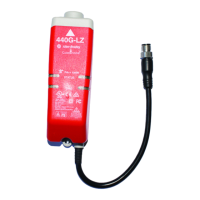Rockwell Automation Publication 440G-UM001C-EN-P - June 2019 19
Installation Chapter 3
the enclosure of the switch that contains the electrical components and the
switch function is not impaired.
This rating does not promise protection from any liquids other than water and
does not promise the mechanical longevity from continuous or frequent
exposure.
However, the 440G-LZ safety switch is used in CIP (clean-in-place)
applications by virtue of the following features:
• Stainless steel is used for all metal parts including the M12 quick-
disconnect.
• The product plastics are resistant to most alkaline cleaners used in CIP.
• An internal nitrile-rolling lip seal guards the locking bolt, which extends
and retracts during locking/unlocking.
Removal of the Actuator Plug
This plug can be broken out from the actuator if a through-hole is required to
avoid a food trap when mounted on the hazard side of a guard door.
Twist the plug with a screwdriver until it comes apart.
Figure 7 - Removal of Actuator Plug
IMPORTANT To be sure of maximum longevity when exposed to CIP, it is recommended
that the switch be mounted in the inverted position with the actuator at the
bottom. This position allows liquids to drain away from the locking bolt.
Removing the plug in the middle of the actuator improves drainage (see
Removal of the Actuator Plug
).
It is also recommended that the switch be thoroughly rinsed with water
after exposure to CIP. This step prevents adverse effects that may occur with
long-term exposure.

